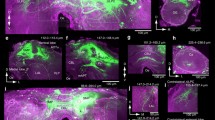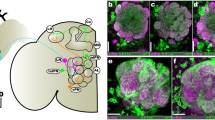Summary
The activity of olfactory projection neurons was recorded extracellularly in the macroglomerulus (mg) of the deutocerebrum of Periplaneta americana and their anatomy was investigated by cobalt stainings. These neurons are particularly sensitive to periplanone B, one of the two main components of the female sex pheromone. The neurons can be assigned to two subgroups on the basis of their receptive fields on the antenna:
-
Neurons with global receptive fields give responses of similar intensity regardless of the antennal region that is stimulated. Their dendrites are uniformly distributed throughout the mg.
-
Neurons with local receptive fields respond only to stimuli applied to a particular part of the antenna. The position of this receptive field varies within the group. The dendrites branch profusely in the lateral region of the mg.
In each deutocerebrum there are several neurons with different, overlapping receptive fields. Due to the presence of projection neurons with different receptive fields, information about the site of stimulation is available in the deutocerebrum. This information is derived from the processing of olfactory inputs, with no involvement of mechanosensory signals.
Similar content being viewed by others
Abbreviations
- mg:
-
macroglomerulus
- PA :
-
periplanone A
- PB :
-
periplanone B
- swB :
-
single-walled B
References
Bacon JP, Altman JS (1977) A silver intensification method for cobalt-filled neurones in wholemount preparations. Brain Res 138:359–363
Bell WJ, Tobin TR (1981) Orientation to sex pheromone in the American cockroach: analysis of chemo-orientation mechanisms. J Insect Physiol 27:501–508
Boeckh J (1974) Die Reaktion olfaktorischer Neurone im Deutocerebrum von Insekten im Vergleich zu den Antwortmustern der Geruchssinneszellen. J Comp Physiol 90:183–205
Boeckh J, Boeckh V (1979) Threshold and odor specificity of pheromone-sensitive neurones in the deutocerebrum of Antheraea pernyi and A. polyphemus (Saturnidae). J Comp Physiol 132:235–242
Boeckh J, Ernst KD (1987) Contribution of single unit analysis in insects to an understanding of olfactory function. J Comp Physiol A 161:549–565
Boeckh J, Selsam P (1984) Quantitative investigation of the odour specificity of central olfactory neurones in the American cockroach. Chem Senses 9:369–380
Boeckh J, Ernst KD, Sass H, Waldow U (1984) Anatomical and physiological characteristics of individual neurones in the central antennal pathway of insects. J Insect Physiol 30:15–26
Burrows M, Boeckh J, Esslen J (1982) Physiological and morphological properties of interneurones in the deutocerebrum of male cockroaches which respond to female pheromone. J Comp Physiol 145:447–457
Ernst KD, Boeckh J (1983) A neuroanatomical study on the organisation of central antennal pathways in insects. Cell Tissue Res 229:1–22
Hartmann N (1988) Eigenschaften der ‘Pheromonsensillen’ der Schabe Periplaneta americana L. Ph D Thesis, Universität Regensburg
Hösl M (1989) Receptive fields on the antenna for pheromonesensitive projection neurones in the American cockroach. In: Elsner N, Singer W (eds) Dynamics and plasticity in neuronal systems. Proc 17th Göttinger Neurobiol Conf. Thieme, Stuttgart New York, p 67
Kafka WA (1970) Molekulare Wechselwirkungen bei der Erregung einzelner Riechsensillen. Z Vergl Physiol 70:105–143
Kanzaki R, Shibuya T (1986) Identification of the deutocerebral neurones responding to the sexual pheromone in the male silkworm moth brain. Zool Sci 3:409–418
Kanzaki R, Arbas EA, Strausfeld NJ, Hildebrand JG (1989) Physiology and morphology of projection neurones in the antennal lobe of the male moth Manduca sexta. J Comp Physiol A 165:427–453
Kennedy JS (1983) Zigzagging and casting as a programmed response to wind-borne odour: a review. Physiol Entomol 8:109–120
Kramer E (1975) Orientation of the male silkmoth to the sex attractant bombycol. In: Denton D, Goghlan JO (eds) Olfaction and taste vol 5. Academic Press, New York, pp 329–335
Martin H (1964) Zur Nahorientierung der Biene im Duftfeld. Zugleich ein Nachweis für die Osmotropotaxis bei Insekten. Z Vergl Physiol 48:481–533
Matsumoto SG, Hildebrand JG (1981) Olfactory mechanisms in the moth Manduca sexta: response characteristics and morphology of central neurones in the olfactory lobe. Proc R Soc Lond B 213:249–277
Murlis J, Jones CD (1981) Fine-scale structure of odour plumes in relation to insect orientation to distant pheromone and other attractant sources. Physiol Entomol 6:71–86
O'Shea M (1980) Cobalt staining of neurones by microelectrodes. In: Strausfeld NJ, Miller TA (eds) Neuroanatomical techniques. Springer, Berlin Heidelberg New York, pp 343–358
Rees D (1974) The spontaneous release of transmitter from insect nerve terminals as predicted by negative binomial theorem. J Physiol 236:129–142
Rust MK, Burk T, Bell WJ (1976) Pheromone stimulated locomotory and orientation responses in the American cockroach Periplaneta americana. Anim Behav 24:52–67
Sass H (1983) Production, release and effectiveness of two female sex pheromone components of Periplaneta americana. J Comp Physiol 152:309–317
Schaller D (1978) Antennal sensory system of Periplaneta americana L. Distribution and frequency of morphologic types of sensilla and their sex-specific changes during postembryonic development. Cell Tissue Res 191:121–139
Seelinger G (1985) Behavioural responses to female sex pheromone components in Periplaneta americana. Anim Behav 33:591–598
Waldow U (1975) Multimodale Neurone im Deutocerebrum von Periplaneta americana. J Comp Physiol 101:329–341
Waldow U (1977) CNS units in cockroach (Periplaneta americana): specificity of response to pheromones and other odour stimuli. J Comp Physiol 116:1–17
Author information
Authors and Affiliations
Rights and permissions
About this article
Cite this article
Hösl, M. Pheromone-sensitive neurons in the deutocerebrum of Periplaneta americana: receptive fields on the antenna. J Comp Physiol A 167, 321–327 (1990). https://doi.org/10.1007/BF00192567
Accepted:
Issue Date:
DOI: https://doi.org/10.1007/BF00192567




